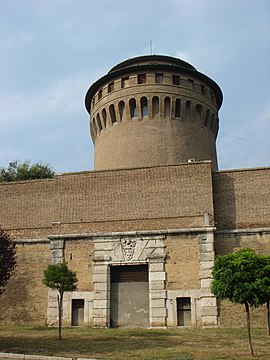 Porta Pertusa with the Tower of S. Giovanni in the background | |
 Click on the map for a fullscreen view | |
| Location | Rome |
|---|---|
| Coordinates | 41°54′04″N12°26′50″E / 41.9012°N 12.4473°E |
Porta Pertusa is one of the gates of the Leonine Wall in Rome (Italy).
 Porta Pertusa with the Tower of S. Giovanni in the background | |
 Click on the map for a fullscreen view | |
| Location | Rome |
|---|---|
| Coordinates | 41°54′04″N12°26′50″E / 41.9012°N 12.4473°E |
Porta Pertusa is one of the gates of the Leonine Wall in Rome (Italy).
It is constituted by three openings: two secondary accesses on both sides of the main gate, surrounded by a majestic bossage. Nowadays it is walled up and rises in Viale Vaticano, close to the street of the same name; it is overlooked by the tower of San Giovanni (restored by Pope John XXIII, who resided in it during the last years of his papacy), that is the south-western bastion of the former Leonine Wall.
The age of its construction is quite controversial (the same as Porta Cavalleggeri). It probably dates back to the return of Popes from the Avignon Papacy, that is the end of the 14th century, when the pontiffs, coming back to Rome from Avignon with a large retinue, took up definitively their residence in the Vatican (thus leaving their previous residence in the Lateran) and the three gates of the Leonine Wall [1] turned out to be too few to meet the needs of the resulting population and building increase. It was created by drilling the former walls (in late Latin pertusus means "drilled") and probably its use was only destined to the Curia and not to the town traffic. Stefano Piale, having observed that there is no mention preceding that of the humanist Flavio Biondo, thinks that it was erected by Antipope John XXIII, thus dating it at the first quarter of the 15th century. On the other hand, a document dating back to 1279 could make reference to it.
Almost no document refers to the postern placed just a little farther; the only known text calls it Porta Palatii.
The most substantial restoration, also involving the whole western stretch of the wall, was probably carried out by Pope Pius IV in 1565; the Pope died before the completion of the work, though a plaque with the coat of arms of his family, the Medici, has been placed close to the gate.
The gate was probably closed and re-opened several times: just one of these circumstances is known, since a 1655 document reports that it was opened during the visit of Queen Christina of Sweden. [2] During the French siege of Rome in 1849 the French army regarded the Porta Pertusa as a possible way into the city, even though it had been walled up some years previously. The reason for this was that recent French maps incorrectly showed the gate as operational. [3]
![]() Media related to Porta Pertusa at Wikimedia Commons
Media related to Porta Pertusa at Wikimedia Commons
| Preceded by Porta Cavalleggeri | Landmarks of Rome Porta Pertusa | Succeeded by Porta Santo Spirito |

The Porta Capena was a gate in the Servian Wall in Rome, Italy. The gate was located in the area of Piazza di Porta Capena, where the Caelian, Palatine and Aventine hills meet. Probably its exact position was between the entrance of Via di Valle delle Camene and the beginning of Via delle Terme di Caracalla, facing the curved side of the Circus Maximus.
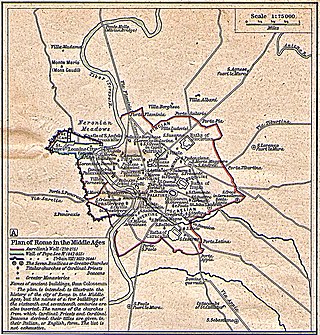
The Leonine City is the part of the city of Rome which, during the Middle Ages, was enclosed with the Leonine Wall, built by order of Pope Leo IV in the 9th century.

The Aurelian Walls are a line of city walls built between 271 AD and 275 AD in Rome, Italy, during the reign of the Roman Emperor Aurelian. They superseded the earlier Servian Wall built during the 4th century BC.

Borgo is the 14th rione of Rome, Italy. It is identified by the initials R. XIV and is included within Municipio I.

The Porta San Paolo is one of the southern gates in the 3rd-century Aurelian Walls of Rome, Italy. The Via Ostiense Museum is housed within the gatehouse. It is in the Ostiense quarter; just to the west is the Roman Pyramid of Cestius, an Egyptian-style pyramid, and beyond that is the Protestant Cemetery.

The Porta del Popolo, or Porta Flaminia, is a city gate of the Aurelian Walls of Rome that marks the border between Piazza del Popolo and Piazzale Flaminio.
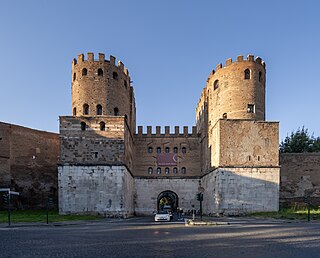
The Porta San Sebastiano is the largest and one of the best-preserved gates passing through the Aurelian Walls in Rome (Italy).
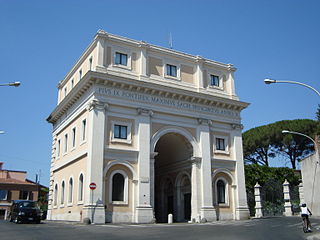
Porta San Pancrazio is one of the southern gates of the Aurelian walls in Rome, Italy.

Porta Portese is an ancient city gate, located at the end of Via Portuense, where it meets Via Porta Portese, about a block from the banks of the Tiber in the southern edge of the Rione Trastevere of Rome, Italy.

Porta San Giovanni is a gate in the Aurelian Wall of Rome, Italy, named after the nearby Archbasilica of Saint John Lateran.
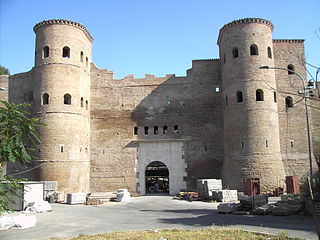
The Porta Asinaria is a gate in the Aurelian Walls of Rome. Dominated by two protruding tower blocks and associated guard rooms, it was built between 271 and 275 AD, at the same time as the Wall itself. Unlike most of the other gates, it was not rebuilt or fortified by Honorius or restored by Theodoric.

Porta Settimiana is one of the gates of the Aurelian walls in Rome, Italy. It rises at the northern vertex of the rough triangle traced by the town walls, built by Emperor Aurelian in the 3rd century, in the area of Trastevere and up through the Janiculum.

The Porta Nomentana was one of the gates in the Aurelian Walls of Rome, Italy. It is located along viale del Policlinico, around 70 m east of Porta Pia. It is now blocked and merely a boundary wall for the British Embassy.

Porta Santo Spirito is one of the gates of the Leonine walls in Rome (Italy). It rises on the back side of the Hospital of the same name, in Via dei Penitenzieri, close to the crossing with Piazza della Rovere.

The Janiculum walls are a stretch of defensive walls erected in 1643 by Pope Urban VIII as a completion of the Leonine wall and for a better protection of the area of Rome rising on the right bank of the Tiber.

Porta Angelica was a gate of the Leonine Wall in Rome (Italy).

Porta Cavalleggeri was one of the gates of the Leonine Wall in Rome (Italy).

Porta Ardeatina was one of the gates of the Aurelian Walls in Rome (Italy). The gate was built in the time of Nero. It stands at an angle in the Aurelian Walls.

The Porta Viminale was a gateway in the Servian Wall of ancient Rome, at the centre of the most exposed stretch of the wall between the Porta Collina and the Porta Esquilina. These three gates and the Porta Querquetulana were the oldest in the wall.

Porta Caelimontana and Porta Querquetulana were two city gates that opened in the Servian Wall in Rome (Italy); only the first one is still existing.